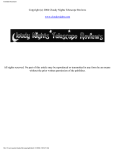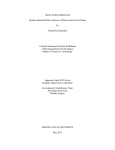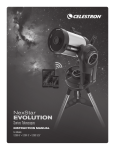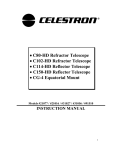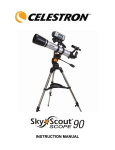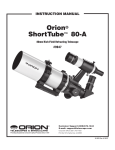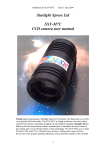Download Celestron NEXSTAR 130GT
Transcript
Copyright (c) 2005 Cloudy Nights Telescope Reviews Celestron NEXSTAR 130GT 130mm f/5 Newtonian "Computerized" Telescope by David Knisely MSRP: $380 The era of Go-To telescopes has been firmly established over the past 10 years or so. However, most of these instruments have tended to be fairly complex and costly pieces of equipment. Enter the Celestron NexStar 130GT telescope: a modest and light GoTo telescope with some of the same features as its larger brethren. THE OTA The 130GT is a 5.1 inch (130mm clear aperture) f/5 Newtonian on a single arm Go-To altazimuth mount which can slew to and track a variety of celestial objects. The telescope tube itself is about 24 inches (610mm) long and about 6.5 inches (165mm) in width. The tube is made of thin steel that is painted a light silver on the outside and a light flat-black on the inside. The primary mirror is mounted on a rather close-fitting 3-point mirror cell with both adjustment and locking screws. The primary does have a small ring reinforcer placed at its center, which is a considerable aid when collimating (aligning) the telescope's mirrors. The secondary is a 1.5 inch minor-axis elliptical mirror which is glued to a cylinder that is fixed to an adjustable 3-screw cell mounted on a 4-vane spider of adequate quality. This results in a linear central obstruction of about 29%, which is high for a Newtonian but probably fairly typical for a "Richest-field" telescope designed for wide-field work. The back of the secondary mirror was not precisely centered on the short cylinder it was glued to for fastening it to the secondary holder (the "spider"), as it was nearly 3 millimeters closer to the side of the tube opposite the focuser. A very slight offset in that direction is sometimes required for short f/ratio "richest-field" Newtonians in order to catch all Copyright (c) 2005 Cloudy Nights Telescope Reviews the light from the primary, but in the case of a 5.1 inch f/5, the required offset amount should actually be fairly negligible and the center of the secondary mirror should really be very close to being on the optical axis of the telescope. Thus, it appears that much of the off-axis positioning of the secondary mirror in this NexStar is a slight error in the gluing placement of the mirror rather than something designed to really be this way. From the secondary size, the maximum fully illuminated field will be on the order of 0.6 degrees, which may be a bit on the small side for a "richest-field" telescope. The focuser is a standard 1.25" rackand-pinion unit which ranges in height from 3.25 inches to 5.25 inches above the tube surface. The focuser has two set screws to hold the eyepiece in place, as well as being threaded on the eyepiece end with threads similar to that of a standard camera "T" adapter. The telescope is provided with a Celestron "red dot" finder in a metal dove-tail base near the front of the tube. This base will also accept many of the smaller single stalk optical finder mounts. The instrument also comes with 25mm (26x, 2.1 degree true field) and 10mm (65x, 0.97 degree true field) Plossl eyepieces. THE MOUNT The NexStar mount is a modified version of the driven altazimuth ones used for the rest of the "low-end" NexStar GT series. The fork is a black single arm unit tilted back at roughly a 45 degree angle from the vertical with the fork arm offset slight from the azimuth axis. The core of the fork is an aluminum casting, but it is covered by a black plastic housing that shields some of the electronics as well as the altitude drive motor and clutch. A large clamshell style cradle known as the "tube Clamping Ring" is provided to hold the optical tube assembly, and is mounted firmly to the upper bearing of the fork. The clamping ring is opened by removing a large thumbscrew, and the unit can be adjusted so as to allow the tube to be rotated to a convenient viewing Copyright (c) 2005 Cloudy Nights Telescope Reviews position. The azimuth motor is also partially covered with a plastic housing. Two jacks sit near the base of the fork arm: one power jack for 12VDC electrical power, and a second "telephone" style jack for the hand controller. The base of the fork arm sits in the bowl shaped top of a thin wall light duty aluminum tripod which has plastic locking knobs on the leg extensions. These locking mechanisms are a little on the delicate side, so the knobs should not be excessively tightened (they may break). In addition, the wing nuts used to fasten the tripod legs to the tripod top are thin pot metal and are also easy to break (one was found to be partially broken even before the scope was taken out of the box for assembly). The mount simply is placed on the tripod and a very broad somewhat conical knob underneath is turned to tighten things down. Setup time is thus very quick (excluding the time it takes to level the tripod and to get the scope's electronics up and tracking). The tripod has a 3-armed central folding spreader which also acts as the support for a small rotating accessory tray. The accessory tray also has a holder for the hand controller. The extendable tripod allows the base of the mount to be anywhere from 25 to 46 inches above the ground, although for greatest stability, I would recommend that the legs not be extended to full height. The entire scope set up weighs in at only 18lbs, so for many people, it may be light enough to just carry fully assembled out to where it is to be used. ELECTRONICS AND OPERATION The NexStar 130GT is designed to operate as a fully electronic telescope (i.e.: it is difficult to use manually). The unit operates on 12 volts DC with a 750mA current draw, and is supplied with a small battery pack which will hold eight AA cells. This power pack has a cord nearly 4 feet in length and a standard DC power plug on one end. While this battery pack will work with the scope, I would still recommend either a decent 12V power supply that works off of house current Copyright (c) 2005 Cloudy Nights Telescope Reviews or a large capacity DC battery system like the Celestron "Power Tank". The telescope can be electrically slewed in any of nine different speed ranges (maximum speed is 4 degrees per second). The hand controller provides the control and pointing of the telescope and is identical in appearance to those used on the rest of NexStar series, but differs electronically. It is connected to the telescope's electronics by a coiled cord which can be stretched from two to four feet from the scope. At the base of the hand controller is another "phone jack" which will allow a laptop with the right software and a connecting serial cable to control and point the NexStar. However, unlike the more advanced NexStar "i" and "GPS" series, there is not a receptacle on the fork for conveniently holding the hand controller when it is not being directly used. Much of the time, I ended up either draping the controller and cord over the telescope's tube or just letting it hang over the right side of the fork arm, as the cord tended to "wrap up" around the tripod if left hanging. The hand controller has 19 back-lit buttons for slewing and command inputs to the NexStar's internal computer, and a 16 character/2-line side-scrolling back-lit LCD display for messages and data. The LCD display window allows messages such as alignment prompts, object data, and the various menus and utilities to be displayed. During Go-To slews, a small rotating slash appears at the right edge of the window to let the user know that the slew is still in progress. When it vanishes, the Go-To is complete and the object should be in the field of view. In the case of over 100 objects, one touch of the "INFO" key will cause the display to scroll a long description across its window describing various aspects of the object currently in view. The speed of the scrolling is controllable with the push of a button, which is a real convenience. The display tended to get a little sluggish at temperatures much below 28F, and at temperatures below zero, it may go completely blank. I recommend that the Copyright (c) 2005 Cloudy Nights Telescope Reviews hand controller be kept in a warm place prior to powering the scope up, as the electrical current flowing through the unit seems to help prolong its operating time at low temperatures. The alignment setup is generally in one of three modes: 1. AUTO 2. 2-STAR 3. QUICK ALIGN The first step in all of these is to make certain that the telescope's tripod is level. Unfortunately, no bubble level is supplied with the scope, so one must be purchased. Once the tripod is leveled, the mount is attached to the tripod and the electronic alignment can begin. The AUTO method takes the user through a series of alignment steps where the scope is leveled in altitude (i.e.: horizontal to the ground) and pointed as close to true north as possible. Then, inputs of location, date, and time are entered. When these are entered, the telescope slews to the first of two selected stars to begin its alignment. The red-dot finder should be aligned with the main telescope prior to setup, and the scope will first ask the user to set the star on the red dot and then tweak the alignment further by looking into the eyepiece to truly center the first star. Once that is done, the scope slews to its second alignment star, and the process is repeated. The scope announces the alignment a success, prompts you to turn off the red-dot finder, and the user should be ready to begin Go-To operation. The 2-STAR alignment is similar, except that the user merely selects two stars and aligns the scope on each one without the input of date, time, and precise location. The QUICK ALIGN just requires input of location, date, and time, asking you to point the scope level and to the north for alignment. The QUICK ALIGN mode is probably the fastest, but is also the least accurate. One nice item is that once you enter your location data, the telescope can remember it, although you will still need to update the date and time. For finding things, the NexStar has a database of 4033 objects including the planets, moon, named stars, prominent double stars, some variable stars, asterisms, and a selection of deep-sky objects from the Messier and NGC catalogs, as well as the Caldwell list. Some, like the Messier and NGC objects, are directly accessible with the push of just a few buttons, while others require a few more button pushes to access. More objects would be available for the telescope to point towards if a laptop control and external software were used, but there is no guarantee that some of these objects would be bright enough to be visible in the telescope's 5.1 inch aperture. Copyright (c) 2005 Cloudy Nights Telescope Reviews THE SKY Level-1 and the NexStar Observer's List software came with the telescope, but the serial cable for an external computer was not provided. The hand controller also provides a series of utilities for telescope control as well as settings for an equatorial mount. However, the NexStar 130GT cannot be mounted equatorially, as no wedge is available for it, and the mounting system is not designed for equatorial use. OPTICAL PERFORMANCE The NexStar 130GT's optics were judged to be fairly good. The scope came slightly out of optical alignment, but it was at least possible to collimate this instrument. The alignment or collimation instructions provided in the manual are woefully inadequate, so it is best to refer to one of the better Newtonian collimation instruction sites on the internet. Basically, what one does is first make certain the center of the primary mirror at the back of the telescope is visible centered in the secondary mirror when looking into the focuser. The secondary mirror can be rotated in its mount by loosening the central screw of the spider, and the other three screws on the spider allow minor tilting of the secondary to get it properly aligned. Collimation of the secondary was a bit of a pain (mostly in the need to fool with a screw locking the rotation of the secondary), but eventually it was achieved. Then, with the three adjusting screws on the back end of the telescope, the primary mirror is adjusted so that the reflection of the spider and secondary mirror is centered in the primary mirror. The large knurled locking screws next to the adjustment screws were a little on the long side, and were sometimes a bit of a pain to use. However, the primary needed very little adjustment to get it aligned properly. That having been said, the telescope holds collimation fairly well on the whole, so bouncing it around as I carried it inside and outside the house didn't change things very much. The red-dot finder has two alignment screws and I had to adjust them over nearly their full range of motion to get the red dot aligned with the main telescope. Once out under the sky, I put in the Ronchi grating and put the scope on Polaris. The Ronchi bands were pretty straight overall, but showed very slight curvature on the very ends of a type indicating a very mild turned-down edge in the telescope's primary mirror. However, the Star test at high power showed very little in the way of spherical aberration and no on-axis astigmatism, with clear diffraction disk and ring structure easily visible in the in-focus star images. Copyright (c) 2005 Cloudy Nights Telescope Reviews The eyepieces were of fair quality, with the 25mm showing considerable astigmatism towards the edges of the 2 degree field it provided. However, with a Tele Vue 24mm Panoptic, images were quite good over a 2.38 degree field. A wide field is necessary for finding things, as the Go-To slews of the NexStar 130GT occasionally don't end up extremely close to the desired object. The focuser height along with the size of the secondary will compromise the outer field illumination however, so as a Richest Field instrument, its not as good as it might be. Still, I did enjoy being able to see the entire sword of Orion and the nebulae involved with it at a single glance. From a dark sky, I could also see the Merope Nebula in the Pleiades. High power planetary images were fairly good as well, with Saturn showing the Cassini division, the main equatorial belt complex, the Crepe ring, and the darker polar region. However, the light scatter around the planet may be an indication of slightly rough mirror surfaces as is often found with some machine-ground optics. I could see Rhea, and Dione with the scope, but they were faint and were more difficult than they should be in a 5.1 inch aperture. The focuser was functional, but was a bit harder to get a good high-power focus due to the stiffness and coarse nature of its motion. The interior of the tube was fairly dark but was not as well blackened as a good astronomical telescope really should be. A bright flashlight made the tube interior look more of a dark grey than black. The red-dot finder was at least functional (and is used more for initial Go-To alignment than as an aid in pointing), but I would have preferred a low power optical finder instead. MOUNT AND ELECTRONICS Overall, the telescope's electronics did do what they were supposed to do, although with varying degrees of success. The telescope slewed to and tracked a number of objects when ordered to through the hand controller. The internal software worked reasonably well with no obvious problems. The motors were somewhat noisier than those in my NexStar 9.25SCT, and when tracking, they produced an odd weak buzzing sound. The slewing at the slower speeds showed a lot of play in the clutches, as it sometimes took a few seconds for the Copyright (c) 2005 Cloudy Nights Telescope Reviews scope to actually move when one of the slew buttons was pressed and held down. The Go-To accuracy was somewhat variable, being usually under a degree from the intended location and in a number of cases, less than half a degree from the target. However, there were a few times when the scope missed its target by quite a margin (the so-called "NexStar Gremlin"). That usually meant that something in the scope's alignment or the orientation of the tripod had gone wrong. A tripod settling into the ground or the scope getting bumped were usually the main causes of this problem, although a low battery or a bad power connection at the jack can also lead to this. Tracking was good at low power, but at high powers (in excess of 100x), it tended to wander somewhat, sometimes letting the object very slowly drift to the edge of the field or beyond. The misses in the Go-To slews, plus the slightly sloppy slewing and tracking will very likely be major sources of frustration for the novice telescope owner who gets one of these NexStar Go-To scopes. In addition, the little external battery pack with the eight "AA" cells did not last all that long, with perhaps three or four 2-hour observing sessions being the most it would support. Colder temperatures really reduced the capacity of the little pack, so it is best to use an external power supply with the NexStar 130GT. Getting the tripod very close to level and the scope pointed accurately North during alignment are the keys to good pointing accuracy with the NexStar 130GT. As such, the tripod should be leveled using a small bubble level *before* the mount is put on the tripod. In addition, the tube needs to be slewed to level when pointed due north early in the alignment procedure, so again, a small carpenter's level that can be placed temporarily on the top side of the telescope tube is a real help here. The more carefully this leveling is done, the better the Go-To slews and tracking will tend to be. Alignment was fairly easy, and in some cases, took less time than it did when doing a full GPS alignment with my NexStar 9.25GPS. I generally slewed the scope to Polaris and then down in altitude to level the tube when starting the alignment. The mount uses friction clutches for its drive system, so the scope can be moved by hand with a little pressure. However, I do not recommend that this be done on a routine basis, as eventually, the clutches may become a little too loose to allow the motors to drive the scope properly. The telescope tube should be placed very near its "balance point" when in its cradle (the center of the tube clamp ring) should be about 8 inches from the back end of the telescope tube). If this is not done, the tracking may not be as accurate due to unequal loading of the altitude drive motor. A loss of alignment can also occur if a person tries to move the scope by pushing it with a little hand pressure, so once alignment is achieved, it is best not to touch the telescope other than to change eyepieces or shut off the red-dot finder. Many of these tips Copyright (c) 2005 Cloudy Nights Telescope Reviews are vital in the proper operation of the scope, but as usual, Celestron's manual does not mention them. Indeed, the manual was only barely adequate to understand a little of how the scope works. It falls well short of a decent guide to the use of the 130GT. While the telescope OTA isn't all that bad, the mount and Go-To system are definitely the areas of the greatest problems. As mentioned earlier, portions of this mount used hardware and construction which seems a bit on the flimsy side. This was especially noticeable at high power, where the vibration and movement of the scope when touched or vibrated by the wind at times made it hard to view. Clearly, the mount may be a bit on the small side. There is little excuse for not using standard steel hardware in places like the wing nuts or the tripod leg locks. Plastic in the leg locks is also somewhat questionable, although I have seen similar features on other small telescope mounts. The power and hand controller connectors are located on the moving fork, which can allow both cords to get wrapped up or pinched in parts of the tripod. I had this happen during a long slew when the cord of the hand controller got wedged between one of the tripod's wing nuts and the mount. I heard the motors suddenly slowing and then noticed the cord being rather heavily stretched, so I managed to stop the slew and untangle things before something really bad happened. This could easily been avoided if, as on the NexStar 9.25 and 11 inch models, some kind of mounting hook had been fixed to the fork to hold both the hand controller and the battery pack. The overall design of the mount shows a number of flaws as well, each of which could have easily been avoided with a little careful thought. The biggest problem is with the altitude range of the scope. While the mount is able to slew through the zenith, the length of the scope when placed in the clamshell of the mount in the balanced position will cause the rear of the telescope tube to strike either the top of the tripod legs or the base of the mount at altitude angles higher than 72 degrees and at certain azimuth positions. This effectively reduces sky coverage to some extent and can cause some additional headaches. Often, this nearzenith area has some of the best seeing in the sky, so there should be no reason why a Go-To altazimuth mount can't provide better access to this rather enlarged version of "Dobson's Hole". I had this problem come up when slewing to the Pleiades. The scope tried to go there, but then stopped, with the bottom of its tube jammed firmly against the base of the mount. There is a utility in the menus of the hand controller which will allow the user to keep the scope from slewing to an altitude higher than a certain limit. This might help somewhat with this problem. Unfortunately, it is not implemented as the default altitude slew limit for the NexStar 130GT. The user has to first know about the limit feature, find it, and set it properly. Also, when the telescope is tracking an object, the slew limits do *not* apply, so Copyright (c) 2005 Cloudy Nights Telescope Reviews the telescope might still hit the top of the tripod legs as a tracked object's altitude exceeded the slew limit value. This would result in not only a tracking failure, but a complete screwup in the alignment. The user would then have to shut the NexStar 130GT off and realign it once again. The scope can be moved forward in the cradle to avoid the tripod legs, but the scope's bottom end still hits the base of the mount at about 82 degrees of altitude. In addition, if the tube is shifted forward, the added weight may cause the clutch in the altitude axis to slip. I noted that if the scope was very far forward from its nominal balanced position and the scope was nearly level, the nose of the scope would slowly sink as the clutch slipped. Tracking was also less than accurate even at moderate powers if the scope is not properly balanced in the clamping ring of the mount. If the arm of the fork had been made just a tad longer, or the tripod legs set a bit farther down in the base, this tube strike problem could have easily been avoided. I did come up with a way to get around this problem by making a thin metal bar with a counterweight on one end (an old power transformer from my junk box). I then put a hole in one end of the bar and used the large thumbscrew style bolt in the clamping ring to hold it in place while the bar held the transformer out beyond the rear end of the telescope tube. With my crude counterweight system, I was able to move the scope forward in the clamping ring to a point where it would balance properly and clear both the tripod legs and the base of the mount. The scope worked pretty well in this modified mode, giving me access to the entire Copyright (c) 2005 Cloudy Nights Telescope Reviews sky, although it looked a little funny. Such a counterweight device could easily have been retrofitted to the scope by Celestron, and could have also been fashioned to provide a nice place to hang the hand controller (a much better place than the little accessory tray). Unfortunately, this has not been done, and I have some doubts as to whether Celestron is really concerned enough about the tube-strike problem to even consider this possible solution. CONCLUDING THOUGHTS The NexStar 130GT poses some interesting problems with the way it operates, so much so that I might have some reservations in recommending it to a beginner. With my experience using the NexStar 9.25GPS, I had little trouble making the 130GT work, but it didn't seem to work well enough to really impress me. The mount is not as well designed as it really should be. It is a bit on the light side, and the occasional annoying problems with the Go-To and tracking are enough to generate some frustration among novice users. That, coupled with an inadequate manual would probably lead to the NexStar 130GT sitting in a closet somewhere gathering dust, rather than being a helpful tool for the new observer. Can the 130GT be a useful instrument to the amateur? Yes, it might make a good "grab and go" scope for someone who knows how the unit works and is willing to put up with the occasional problems that the instrument demonstrates. It has reasonably good optical performance, especially for the cost, and with some care, the electric slewing and Go-To features can be made to function at least well enough for richest-field observations. WHAT I LIKED ABOUT THE NEXSTAR 130GT 1. Light weight. 2. Low cost (for a Go-To telescope). 3. Fairly decent optics. 4. Wide field views. 5. Go-To and computer control capability. 6. Easy assembly. 7. Reasonably quick alignment. WHAT I DID *NOT* LIKE ABOUT THE NEXSTAR 130GT 1. Not very robust construction. 2. Inconsistent Go-To and tracking accuracy. 3. Tube bottom strikes the tripod or base of Fork at high altitude angles. 4. Inadequate tube interior blackening. 5. Excessive play in the motor clutches. 6. Inadequate manual. 7. Not very "novice friendly" in operation. 8. Red-dot finder. 9. Inadequate battery pack. Copyright (c) 2005 Cloudy Nights Telescope Reviews 10. Coarse focuser. 11. No place provided on the fork to mount the hand controller or battery pack to prevent cord "wrap-up" problems SUMMARY The NexStar 130GT 5.1 inch f/5 Newtonian is a low-cost and very portable telescope which provides fairly good optical performance as well as Go-To operation similar to the larger telescopes of the NexStar line. However, the problems which this instrument presented may make it a less than outstanding choice for the beginner or for those who have not already had experience operating Go-To telescopes. Click to discuss this article in the forums












